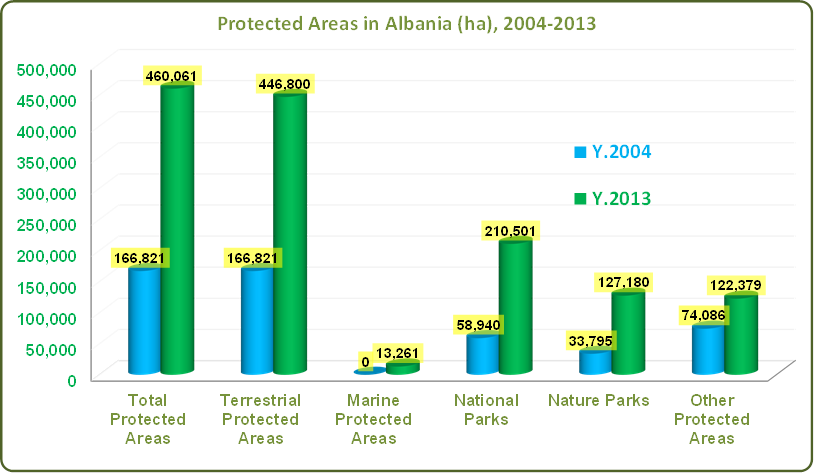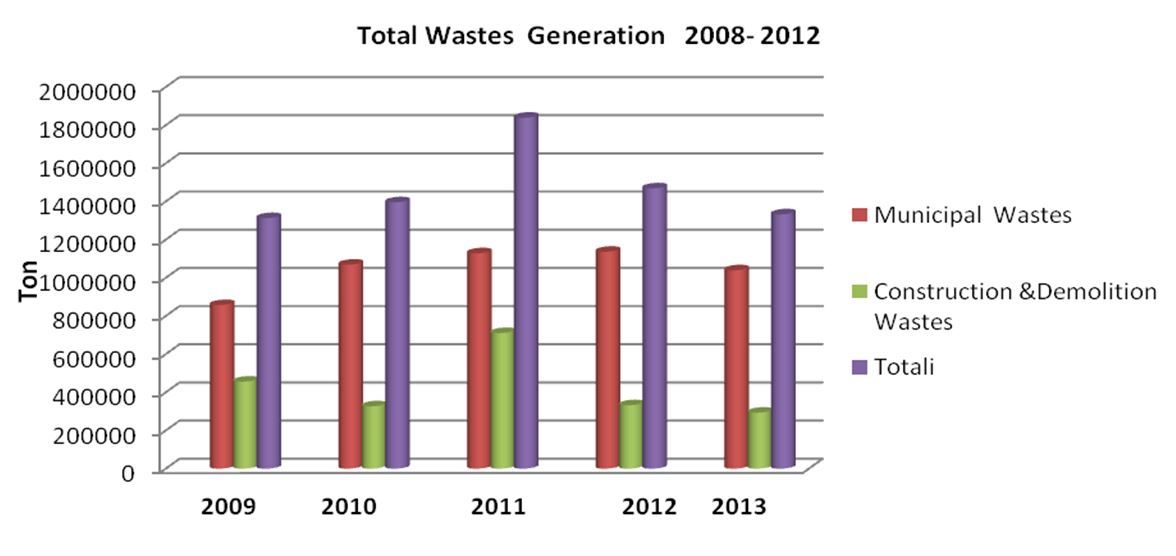Main themes and sectors addressed in the national State of Environment
The State of Environment Report (SoER) is prepared every year by the National Environmental Agency (NEA) and is a legal obligation[1][2]. The environmental indicators used in the Report are based on the data provided mainly by the monitoring of environmental indicators and from information and data provided basically by NEA and other public research and monitoring institutions at the national level.
The SoER[3] shows the state of the main environmental indicators for air, water, biodiversity, soil, climate change, forests etc and is based mainly on the Driving Forces-Pressures-State-Impacts-Responses (DPSIR) framework. Indicators which can not be covered and monitored by the NEA are obtained from the following bodies:
- Various ministries;
- Other public institutions;
- Research and scientific institutes contracted by NEA.
The publication of environmental monitoring data aims to raise public awareness on the state of environment at local and national level. It offers reliable information concerning critical issues, risks, and pressures, which should be under continuous monitoring and supervision.
Key findings of the State of Environment report
The SoER provides information on the state of the main environmental indicators, their trend by giving recommendations and proposing the necessary legislative measures and acts needed to be drafted by policymakers.
The monitoring of urban air quality is focused on indicators for: PM10, PM2.5, O3, NO2, SO2, CO and Benzene. Based on the data assessment from the period 2011 to 2013 in Tirana, a decrease of 20-30% has been observed at the concentration level of PM10 and PM2.5. This is due to improvements made in infrastructure and to several legislative measures undertaken regarding the standardization of used cars and vehicles. At the national level the concentration of CO and Benzene are at levels within the EU standards.
Groundwater monitoring is made on the main watershed basins for chemical parameters, NO3, NO2, NH4, HCO3, Cl, SO4, Na, Ca, Mg,K, Fe, dissolved oxygen, conductivity and hazardous substances. The level of chemical parameters monitored are within the allowed limits. Groundwater in Albania are classified as freshwater and have neutral and weak alkalinity, and strong average hardness. Content is within the maximum allowed values.
The quality of bathing water is focused on the main beaches of Albania for the following microbiological indexes: Enteroccoccus Intestinalis (IE), Coliform faecalis probably Eschericia Coli including sanitary inspection. The classification is based on the WHO/UNEP-UE criteria. According to the assessment made nearly 60% of the coastal bathing water stations in 2013 were classified within the A and B categories (A being excellent quality and B good quality).
Protected Areas (PA) are classified according to the IUCN (International Union for the Conservation of Nature) categorization. The PAs have the greatest ecological, economic, cultural and natural heritage values of the country. Therefore their protection and preservation is of the uppermost importance.
One of the main priorities of the Government over recent years has been the designation of new PAs. This has also been articulated in the National Strategy on Biodiversity[4]. In 2004 the total PA surface area was nearly 9% of the entire country, while in 2013 it covered 16% (Figure 1 shows the PA trend in hectares). The designation of new PAs has influenced biodiversity conservation and protection within and around these areas which in general seems to be well protected. In spite of the positive influence of the new PAs on biodiversity, at present they still face various problems and challenges:
a) habitat degradation from coastal erosion;
b) illegal logging;
c) illegal fishing, poultry and wild animals hunting;
d) inefficient management of recreation activities.
These are critical issues where additional efforts should be addressed.

Continual monitoring of the state of forests[5] takes place and is based on the CORINE classification. Albania is considered a country with high diversity of habitats and forest species. 40 habitats are identified as rare and endangered with the number of endangered species approaching 320. During the last two decades the total forest area decreased by 1.4%. This is due to changing land use categories in forest areas. It is directly related to the transformation and modification of forest lands. These are the basic problems caused by illegal logging, demographic movements, increase in the demand for wood and energy, overuse of forests resources, etc.
Waste management in Albania is decentralized. The responsibility for waste management goes to local government units. The trend of waste generation in total municipal, construction and demolition waste from 2009 to 2011 shows an increase, whereas during 2012 there was a decrease compared to the previous year. Meanwhile a slight increase in municipal waste, and a decrease in construction demolition waste during 2012 in comparison with 2011, was observed (see Figure 2). The new National Plan on Waste Management 2010-2015[6] envisages the treatment and management of waste on a regional basis involving the development of new landfills complying with EU standards.
There is still much work to be done to comply with the standards and requirements of the EU Directives on Waste.

Main policy responses to key environmental challenges and concerns
Albania is working towards European Union integration and the fulfilment of obligations stipulated by the MSA (Stabilisation Association Agreement). In this regard environmental legislation is one of the top priorities. Efforts are being focused on transposing of the EU acquis and Directives concerning Air Quality, Water, Nature Protection and Biodiversity, Wastes, Climate Change, Noise, Chemicals etc.
A new law on environmental protection[7] has been approved and entered into force in 2012. Its objective was to raise the level of environment protection by establishing a consolidated network of environmental institutions at national and regional level linked with environmental policy implementation.
During the period 2013 to 2014 the legislation concerning the Rules and Procedures on Environmental Impact Assessment (EIA) and Environmental Permissions (EP) together with the relevant regulatory package have been drafted and approved[8].
One of the priorities of the Albanian government has been to complete the legislation on Air Quality (AQ) in fully accordance with the EU Directive 2008/ 50/EC. The relevant national law was duly amended.
Progress was made in terms of drafting the legislation regarding the energy efficiency and renewable energy, based on the EU Directives 2001/77, 2003/54/EC, and 2003/55/EC. Accordingly the National Strategy for Energy (2007-2020)[9] was updated.
A new 'Environmental Intersectorial Strategy (2013- 2020)[10]' was recently drafted. The principal objective being sustainable development and protection of natural resources.
Attention is being paid to the completion of the legislation on the waste management in Albania in accordance with the EU Directive on waste 2008/98/EC . The 'National Strategy and Action Plan for the Waste Management[11]' and the law on 'Integrated Management of wastes in Albania[12]' entered into force in 2012. Five regional action plans for waste management for the following regions: Tirana, Elbasan, Durres, Vlora, and Korca were approved.
Country specific issues
The SoER address the main environmental issues and challenges according to the priorities established by the government.
The 'Environmental Intersectorial Strategy 2013-2020[10]' is draft ended and is ready to be approved by the government.
With reference to climate change mitigation, and the Second National Communication (SNC) for Albania, was highlighted that by 2025, the emission reduction by abatement scenario shall reach 48%. Mitigation measures proposed in SND includes all the main sectors such as industry, energy, services, transport, agricultural etc.
There has been an improvement in the quality of coastal bathing waters during recent years. This is due to investments made in the waste water treatment infrastructure. Until a few years ago the main source of pollution for coastal bathing waters has been the discharges of untreated waste water. However, investments made in some of the main cities have changed significantly the quality of bathing water.
One success story worth highlighting is the completion of a national legal framework on the integrated management of waste in accordance with the EU Directive on waste. Much work is needed to fully implement this. In addition, raising public awareness and subsequent engagement in related issues is also necessary as are more investments in building other landfills according to EU standards.
In general Albania has demonstrated progress on environmental issues, regarding the management of environmental problems but still too many efforts are needed especially for the implementation of the environmental legislation.

Document Actions
Share with others